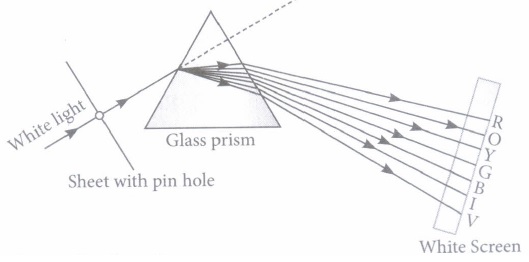In CBSE Class 10 Science Paper, Students will have to answer some questions based on Assertion and Reason. There will be a few questions based on case studies and passage-based as well. In that, a paragraph will be given.
Here we are providing you with Class 10 Science Chapter 11 The Human Eye and The Colourful World Case Study Questions, by practicing these Case Study and Passage Based Questions will help you in your Class 10th Board Exam.
Case Study Chapter 11 The Human Eye and The Colourful World
Here, we have provided case-based/passage-based questions for Class 10 Science Chapter 11 The Human Eye and The Colourful World
Case Study/Passage-Based Questions
Question 1:
When white light is incident on one refracting surface of the prism, the light splits up into constituent colours violet, indigo, blue, green, yellow, orange and red. The process of splitting of white light into its seven constituent colours is called dispersion. When the dispersed white light is made to fall on a screen, we get the band of seven colours is called the spectrum of white light. Red colour bends the least on passing through the prism and violet colour bends through maximum angle on passing through the prism.
(i) The splitting of white light can be done by
| (a) lens | (b) prism |
| (c) mirror | (d) none of these |
Answer: (b) prism
(ii) Which property of light is used by prism to form a spectrum?
| (a) Reflection | (b) Refraction |
| (c) Dispersion | (d) Scattering |
Answer: (b) Refraction
(iv) When a red light passes through a prism, it
(a) will not split
(b) will split into seven colours
(c) will split into white colour
(d) will split into many different colours
Answer: (a) will not split
(v) The spectrum produced by the white light by a prism is called
| (a) pure spectrum | (b) impure spectrum |
| (c) monochromatic spectrum | (d) none of these. |
Answer: (b) impure spectrum
Question 2:
Atmospheric refraction is the phenomenon of bending of light on passing through the earth’s atmosphere. As we move above the surface of the earth, the density of air goes on decreasing. Local conditions like temperature etc. also affect the optical density of the earth’s atmosphere. On account of atmospheric refraction, stars seen appear higher than they actually are; advanced sunrise; delayed sunset, the oval appearance of the sun at sunrise and sunset; stars twinkle, planets do not.
(i) Due to atmospheric refraction, the apparent length of the day
(a) increases
(b) decreases
(c) remains the same
(d) all of these
Answer: (a) Due to atmospheric refraction, apparent length of the day increases by 4 minutes.
(ii) Apparent position of the star appears raised due to
(a) atmospheric refraction
(b) scattering of light
(c) both (a) and (b)
(d) none of these
Answer: (a) Apparent position of the stars appears raised due to atmospheric refraction.
(iii) The sun appears oval-shaped or flattened due to
(a) dispersion
(b) scattering
(c) atmospheric refraction
(d) cannot say
Answer: (c) atmospheric refraction
(iv) Twinkling of stars and non-twinkling of planets is accounted for by
(a) scattering of light
(b) dispersion of light
(c) atmospheric refraction
(d) none of these
Answer: (c) atmospheric refraction
(v) In absence of atmosphere, the colour of sky appears
(a) blue
(b) black
(c) red
(d) yellow
Answer: (d) yellow
You can also practice Class 10 Science MCQ Questions for Board Exams.
